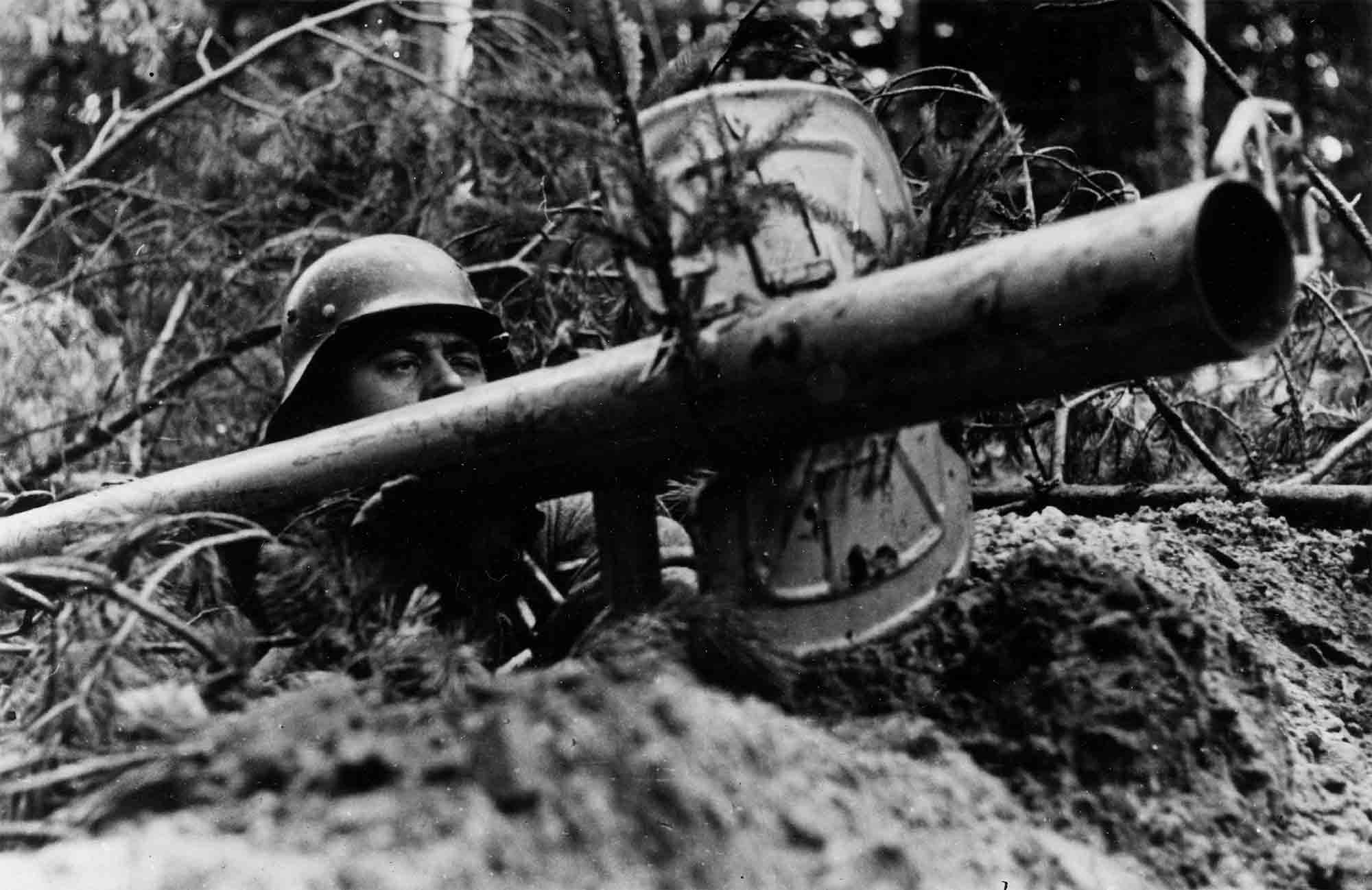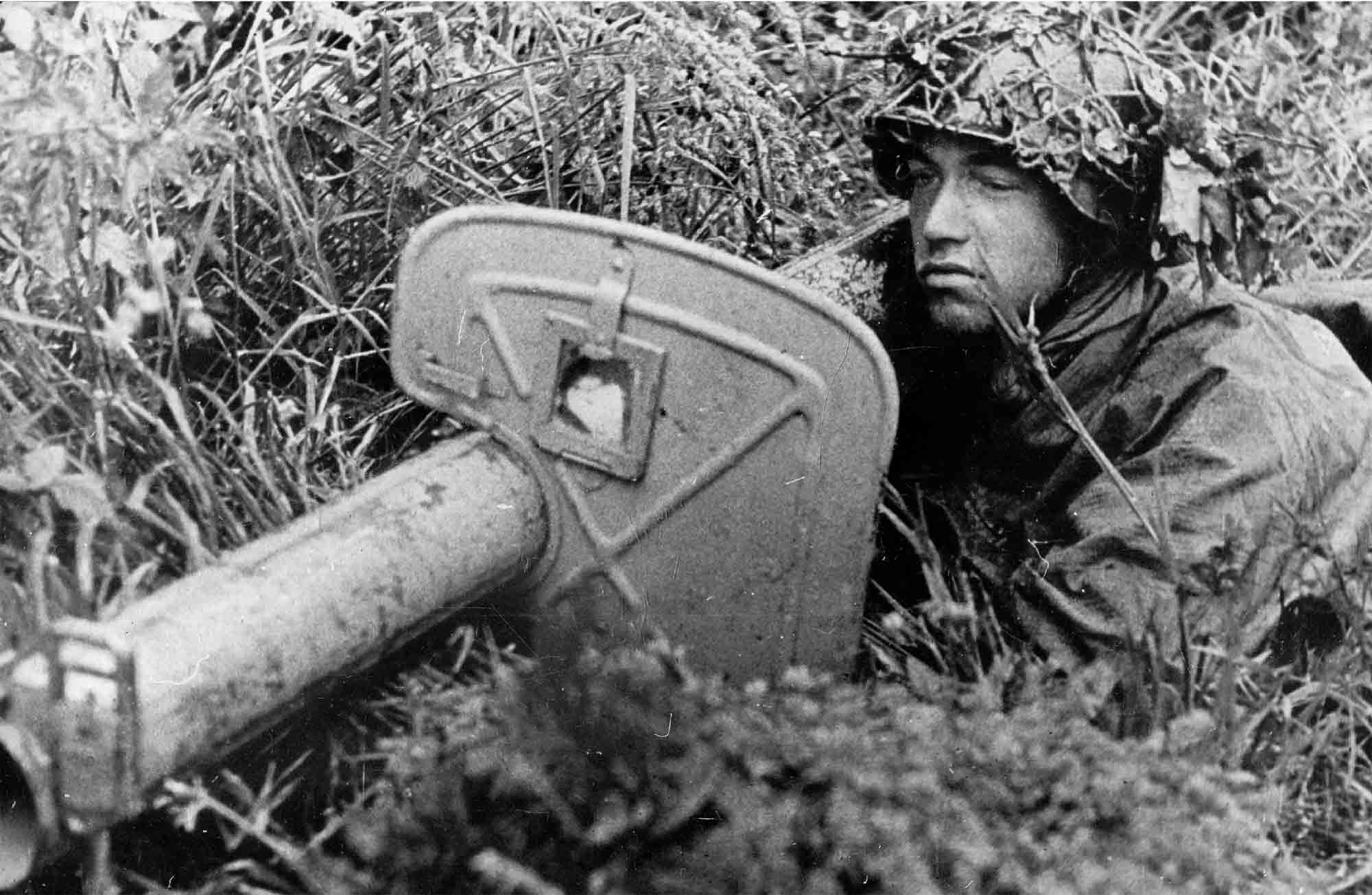Chapter Five
The End
During the first months of 1944 the Germans continued to endure repeated heavy attacks, but the Red Army found the mass of dug-in defences difficult to break.
In total some 20,000 German fighting vehicles, including 8,328 medium and heavy tanks, 5,751 assault guns, 3,617 tank destroyers and 1,246 self-propelled artillery carriages of various types, reached the Eastern Front. Included in these new arrivals were the second generation of tank-destroyers. In fact, tank-destroyers and assault guns would soon outnumber the tanks, which was confirmation of the Panzerwaffe’s importance. But they were stretched along such a thin Eastern Front that they rarely reached their full operating potential.
Russian armour continued to be a constant problem for the PaK and Panzerja¨ger battalions, and the need for more anti-tank support had become desperate. The Germans hastily assembled their next generation tank destroyers and self-propelled artillery vehicles and transported them to the Eastern Front.
The Jagdpanzer IV made its debut in 1944 and was based on the Pz.Kpfw.IV chassis. It was turretless and constructed in three variants. The first was known as the Jagdpanzer IV 0-Serie and was armed with the 7.5cm PaK 39 L/43. The second variant was the Jagdpanzer IV Sd.Kfz.162, armed with the 7.5cm PaK 39 L/48. Its official designation was the Sturmgeschütz neuer Art mit 7.5cm PaK L/48 auf Fahrgestell PzKpfw.IV. A total of 800 were produced in 1944. The last, and the most popular, variant was the IV, armed with a punchy PaK 42 L/70 cannon and named the Panzerja¨ger IV/70. A total of 940 of these vehicles entered service between August 1944 and April 1945.
Another tank destroyer to make its debut in 1944 was the Jagdpanther, or hunting Panther. The vehicle boasted the lethal 8.8cm KwK 43 cannon which was originally fitted on the new Tiger II and mounted on a Panther chassis. The Jagdpanthers served in the heavy anti-tank battalions (schwere Panzerja¨ger-Abteilung), and operated mainly in Russia.
The success of the Jagdpanther, though limited in numbers, prompted the introduction of the Jagdtiger. The Panzerja¨ger Tiger Ausf.B was based on a lengthened Tiger II chassis, and at 71-tonne it was the heaviest fighting vehicle of the war. This tank destroyer boasted a massive 12.8cm PaK 44 L/55 cannon. Just seventy-eight were ever produced and saw limited action on both the Eastern and Western Front.
Despite these additions to the force, it became increasingly obvious during 1944 that both the PaK and Panzerja¨ger units confronting Soviet armour were becoming less effective. The Russians had developed newer and larger anti-tank weaponry of their own with greater armoured protection and adequate firepower to deal with the German arsenal. The Russians were continuing to push the Germans back.
To help deal with Soviet and Allied armour, German infantry, especially Panzergrenadiers, were supplied with the new hand-held personnel anti-tank rocket launcher, the Panzerfaust (tank fist). This was an inexpensive, single shot, recoilless weapon comprising a small, disposable preloaded launch tube which fired a high explosive warhead. The Panzerfaust was first introduced during 1943, but by mid-1944 thousands were being mass-produced. The Panzerfaust 30 was the first to enter production. It had a loaded weight of 5.1kg and was 104.5cm long. The launch tube was made of low-grade steel and the propellant was black powder. Along the side of the tube was a simple folding rear sight and a trigger. The edge of the warhead was used as the front sight and the user would aim the weapon at his target holding it in the crook of the arm. He would then pull the trigger and the warhead would be released, hopefully penetrating the enemy armour. The Panzerfaust had an impressive penetration capability, comparing favourably to the American-made bazooka or the British-made PIAT. On impact it produced a powerful explosion which would create a small hole in thick armour. The blast which entered the tank was quite capable of killing the entire crew inside the vehicle.
For nearly two years, variations of the Panzerfaust were produced. Following the 30 model was the Panzerfaust 60, which was the most common and widely used weapon of its kind, completed in early 1944. It did not reach full production until September 1944, when 400,000 were to be produced each month. It had a better range than the 30 and had an improved flip-up rear sight and trigger mechanism. The Panzerfaust 100 was produced in quantity from September to November 1944. The next production model, Panzerfaust 150, was a major redesign, but was produced in limited numbers near the end of the war. The firing tube was reinforced and reusable for up to ten shots. A new pointed warhead with increased armour penetration and two-stage propellant ignition gave a higher velocity. Production did not start until March 1945, weeks before the end of the war. The last Panzerfaust to be designed was the 250, but this was not to be ready until September 1945.
Another anti-tank weapon that the German infantry used, but was not as widely distributed as the Panzerfaust, was the Panzerschreck or ‘tank shock’. This reusable anti-tank rocket launcher was based on the American bazooka, but was larger and heavier than its American counterpart. The Panzerschreck had an impressive 8.8cm calibre, compared to the 6.0cm calibre of the bazooka. This meant it could penetrate thicker armour, using an existing Raketenpanzerbüchse (RPzB – rocket tank rifle). Gr.4312 designed for the 8.8cm Raketenwerfer (rocket projector) 43. The weapon was shoulder-launched, firing a fin-stabilized rocket with a shaped charge warhead. It was disposable and recoilless like the Panzerfaust. Users were instructed to wear protective gloves, a poncho and a gas mask without a filter. This was to shield the user from the heat of the back blast when the weapon was fired. Later, improvised shields were made to protect the user, and in February 1944 the RPzB 54 was fitted with an official blast shield to protect the operator which made the weapon heavier.
One downside of the Panzerschreck was that it produced a lot of smoke from the back-blast – it soon earned a nickname of the ‘stove pipe’ or Ofenrohr. The main problem with this was that it gave away the user’s position. Consequently, anti-tank teams had to be constantly on the move.
Later in the war the Germans began tactically deploying Panzerschreck and Panzerfaust teams into staggered trenches no further than 115m apart. In this way, attacking enemy armour would be confronted by lines of anti-tank fire from multiple directions at a distance of no more than 69m.
In total, some 290,000 launchers of all variants were manufactured, along with over 2 million rockets. This was an impressive amount of anti-tank weaponry for the German infantryman. But the Russians had too many tanks and German anti-tank crews remained incapable of causing any serious losses or delay to them. As for the new generation of tank hunters – the Jagdtiger, Jagdpanther and Hetzer – whose responsibility it was to repel the huge numbers of enemy vehicles, crews often found themselves outnumbered and exposed to anti-tank fire.
German mobile anti-tank weapons had earned a healthy respect on the battlefield, and Russian tank crews engaged them with caution. But by this stage of the war, production difficulties and the lack of fuel caused never-ending problems. As a result the Russians continued pushing forward while German forces retreated through Poland to East Prussia and then into the Reich itself.
During the last weeks of the war most of the remaining PaK crews, Panzerfaust, Panzerschrek teams and tank hunters continued to fight and defend, holding back the vast tide of enemy vehicles. But they were an overstretched army fighting an overwhelming enemy. Eventually, they were either destroyed or surrendered. But nobody could deny that the anti-tank crews had won a heroic reputation for daring and professionalism in combat.

A group of anti-tank gunners armed with the deadly Panzerfaust slung over their shoulder prepare to move out on an operation in early January 1945. By this late period of the war large numbers of Panzer-faust were issued to front line troops in a radical attempt to stem the enemy onslaught into Germany.
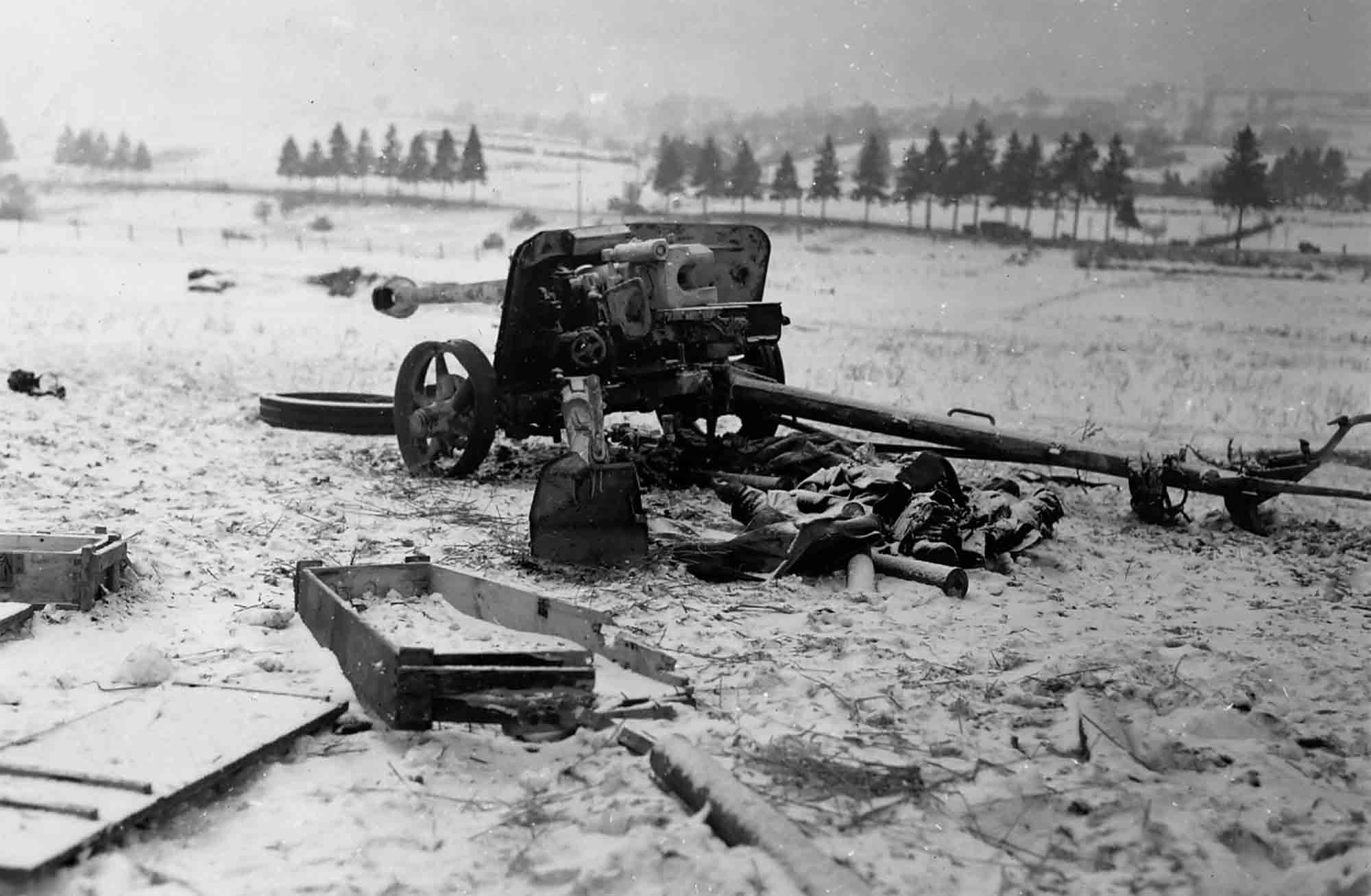
During operations on the Western Front in Belgium, following the defeat of the German Ardennes offensive in January 1945, here in this photograph is a knocked-out 7.5cm PaK 40 with one of the dead anti-tank gunners still lying sprawled out in the snow.

A smiling young grenadier on the way to the front armed with a Panzerfaust. Along the German front lines was a mixture of troops, with mortar emplacements, tanks, PaK and FlaK guns. Behind these defensive positions at varying depths were anti-tank defences, including mortars, Panzerschreck, Panzerfaust, 7.5cm and 8.8cm PaK guns, ready to counter any enemy armoured vehicle that managed to break through. However, while it appeared that the Germans were prepared for attack, equipment employed along the defensive belts was too thinly spread. Commanders were unable to predict exactly where the strategic focal point of an enemy attack would take place.
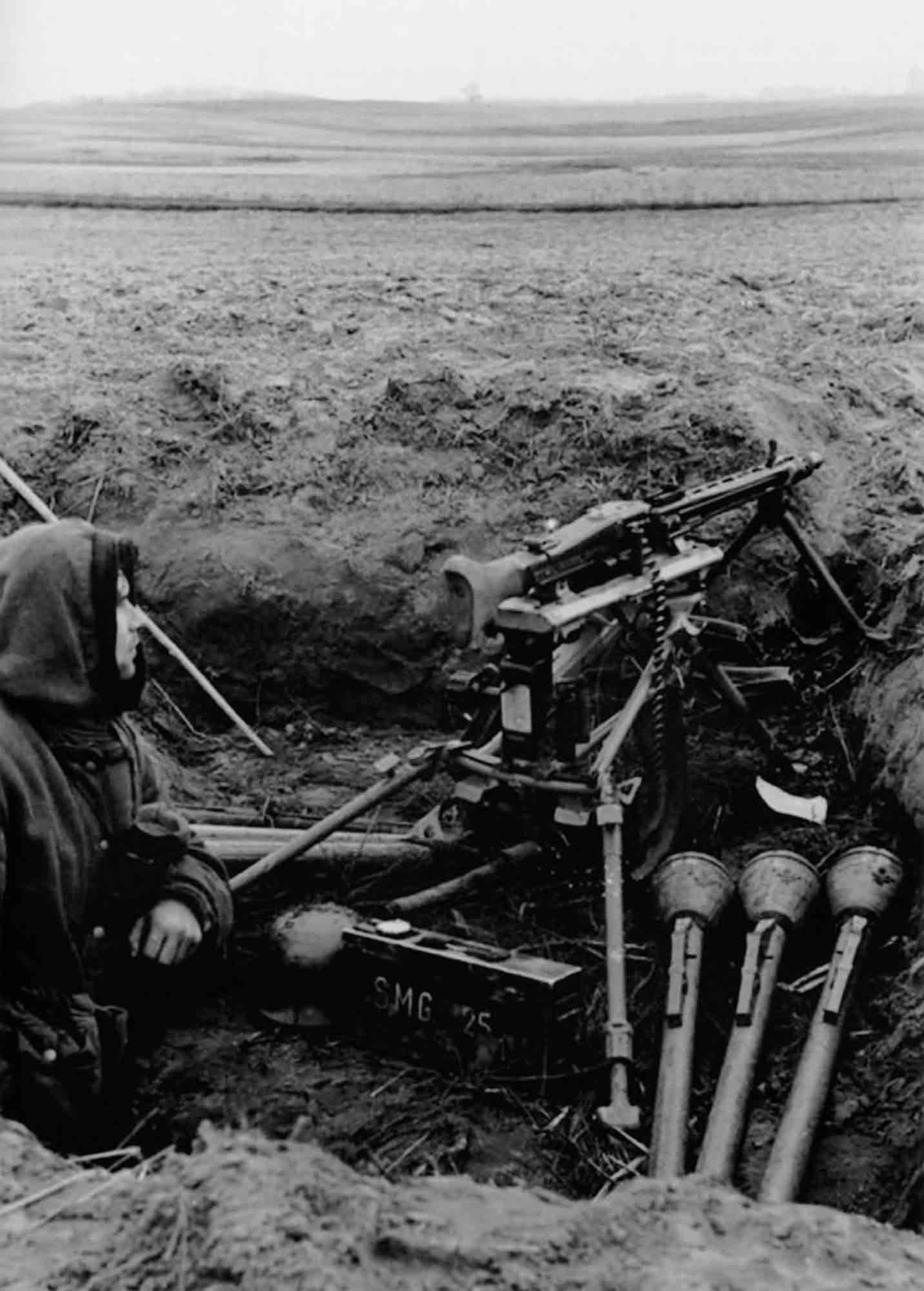
In a defensive position on the Eastern Front is an MG42 machine gunner lying in wait for the advance of the enemy. He has three Panzerfaust lined up waiting for enemy armour to appear.

Along a trench and these Waffen-SS grenadiers armed with the Panzerfaust are taking cover during an attack. When enemy armour approached these troops would emerge from their trench and fire their weapon, discarding the body and withdrawing to another position, often using another Panzerfaust again.
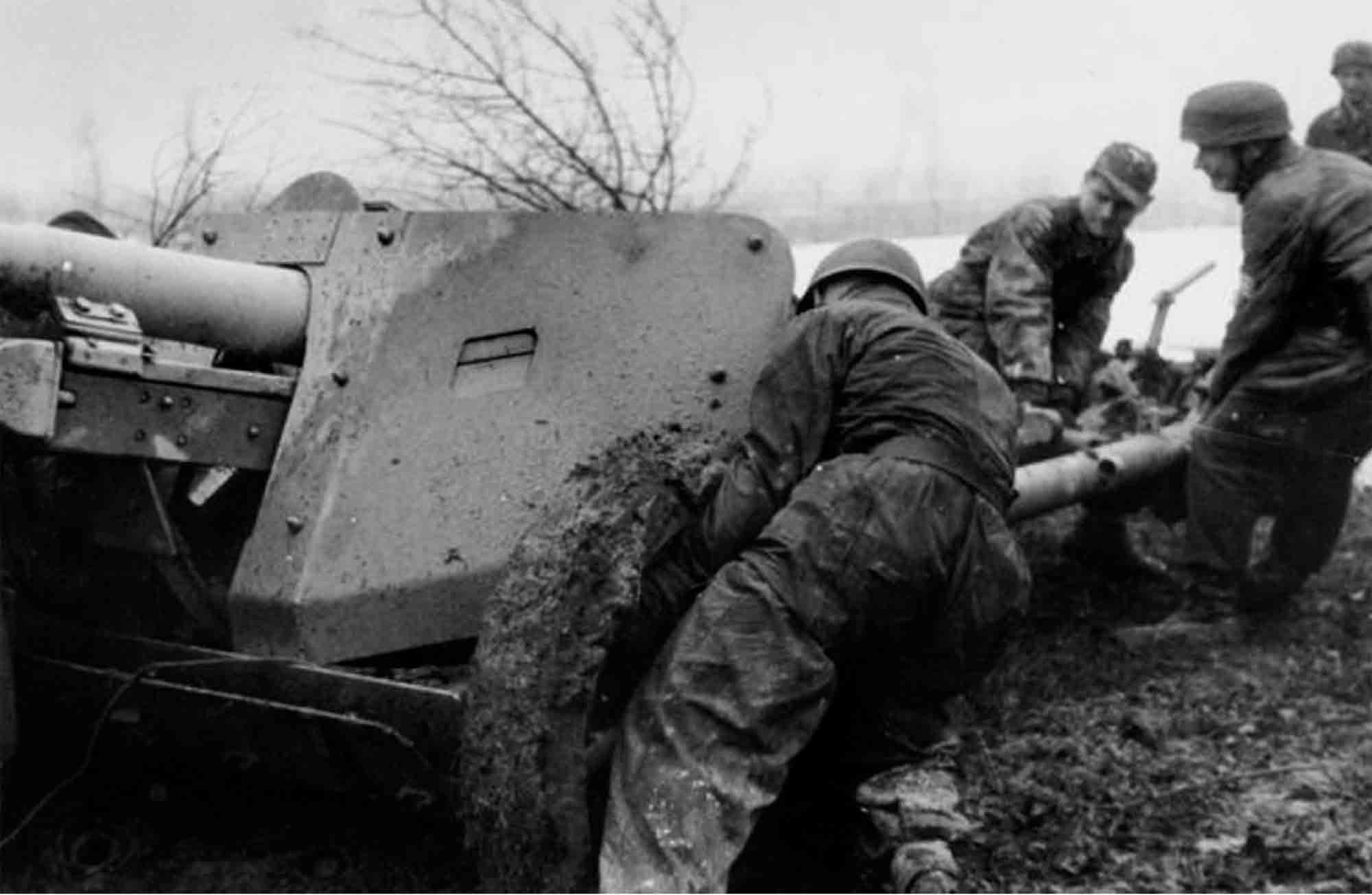
Fallschirmja¨ger (paratroopers) can be seen manhandling this 7.5cm PaK 40 during operations on the Eastern Front in February 1945. By this period of the war the PaK gun had been issued to all armed forces.
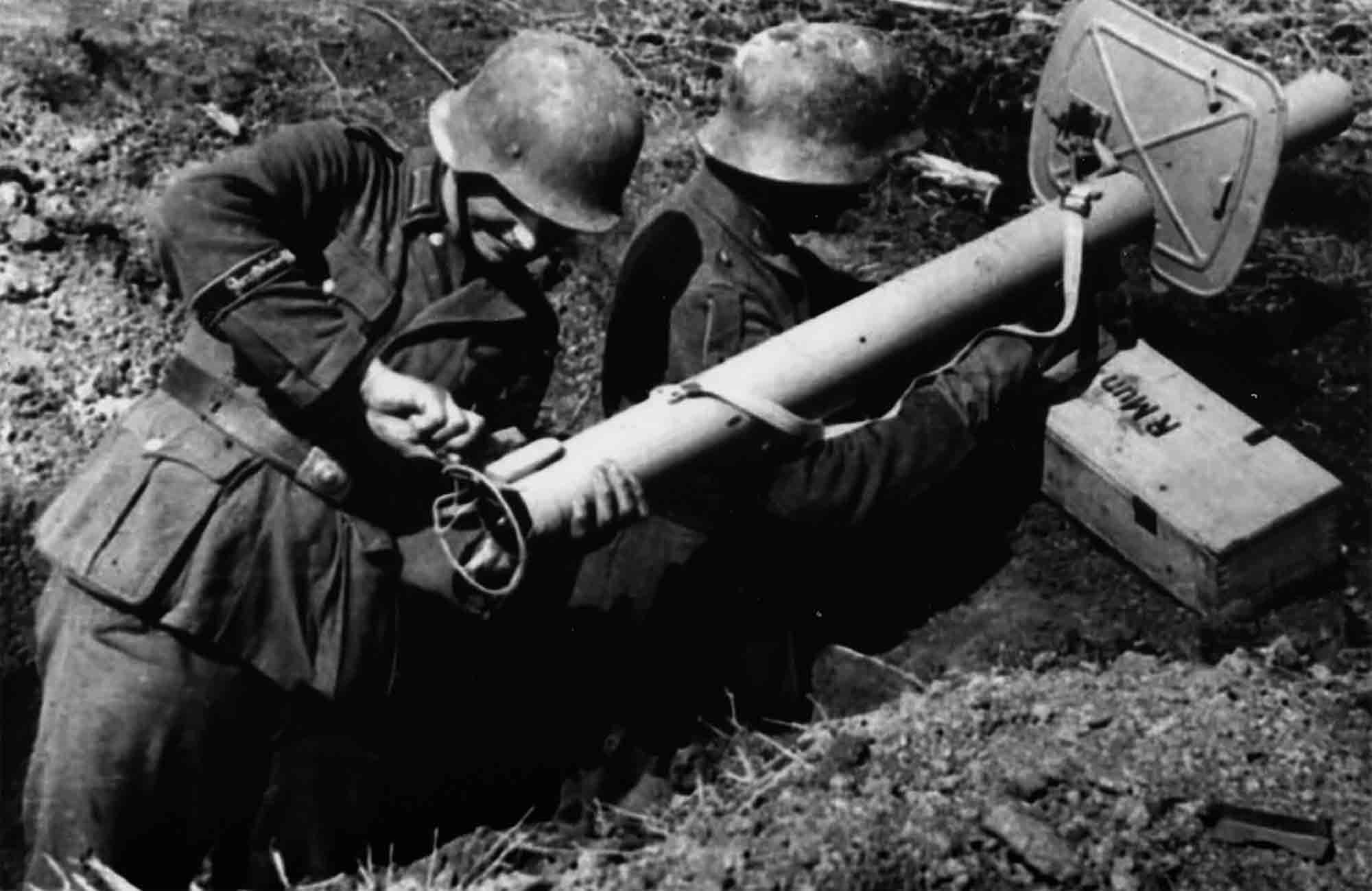
An interesting photograph showing a Panzerschreck being prepared for action. By 1945 there was a dramatic increase in the loss of Russian tanks to the Panzerfaust and more than half of the tanks knocked out in combat were destroyed by Panzerfausts or Panzerschrecks.

A number of grenadiers, four of which are armed with the Panzerschreck are disembarking from an infantry lorry inside a village on the Western Front in 1944. This weapon was first issued in 1943 to units on the Eastern Front and remained on issue for the remainder of the war. As the propellant situation became more critical, other weapons were developed to replace it, but few reached the hands of the troops, so in spite of this logistic drawback it stayed in use. The weapon was highly effective against enemy armour, and was well liked among the soldiers that used it.

Three photographs showing an anti-tank grenadier hidden in the undergrowth with an 8.8cm RPzB 54 anti-tank rocket launcher, known as the Panzerschreck.
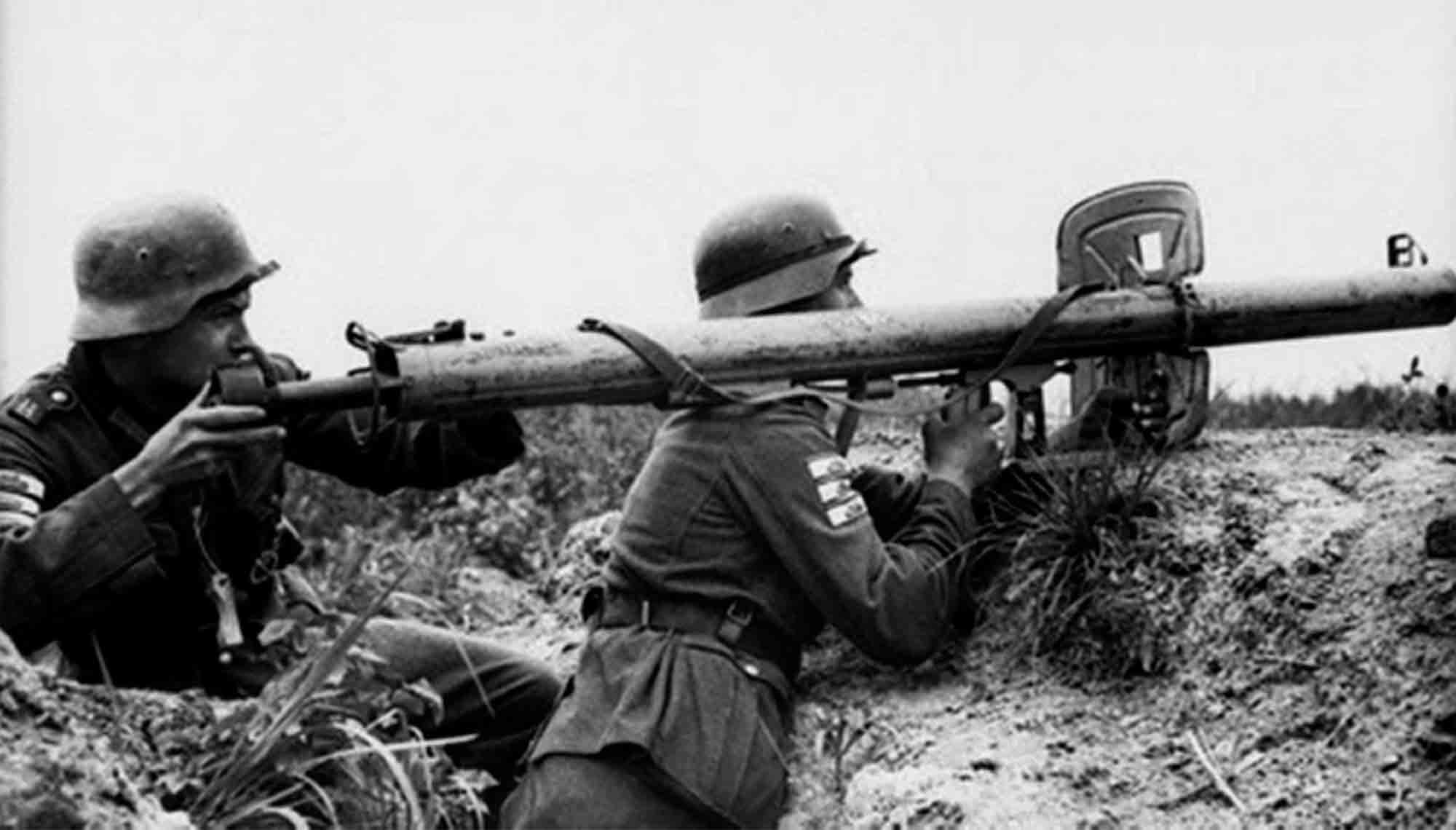
During a fire mission and this Panzerschreck is being reloaded with a projectile for an attack against a target. Although this anti-tank weapon was very effective on the battlefield, firing it generated a lot of smoke both in front and behind. This could give away the firer’s position, making him a target. This often meant moving quickly from one position to another after firing.

A Panzerschreck team comprising the firer and the loader during defensive operations on the Eastern Front late in the war. As the war became increasingly desperate special Panzerschreck and Panzerfaust teams were set up in staggered trenches no further than 115m apart. This was done to attack enemy armour from multiple directions at a distance of no more than 69m. Anti-tank teams were instructed to aim for the thinner side or rear armour whenever possible.

On the front and these grenadiers can be seen sitting in a slit trench during a lull in the fighting. Behind them is a stationary Sd.Kfz.251/10 which has been modified and mounts the 3.7cm PaK 35/36 anti-tank gun. By replacing the front machine gun with this light anti-tank gun, Panzergrenadier units could rely on good fire support and be able to deal with some lighter enemy tanks as they charged across the battlefield.
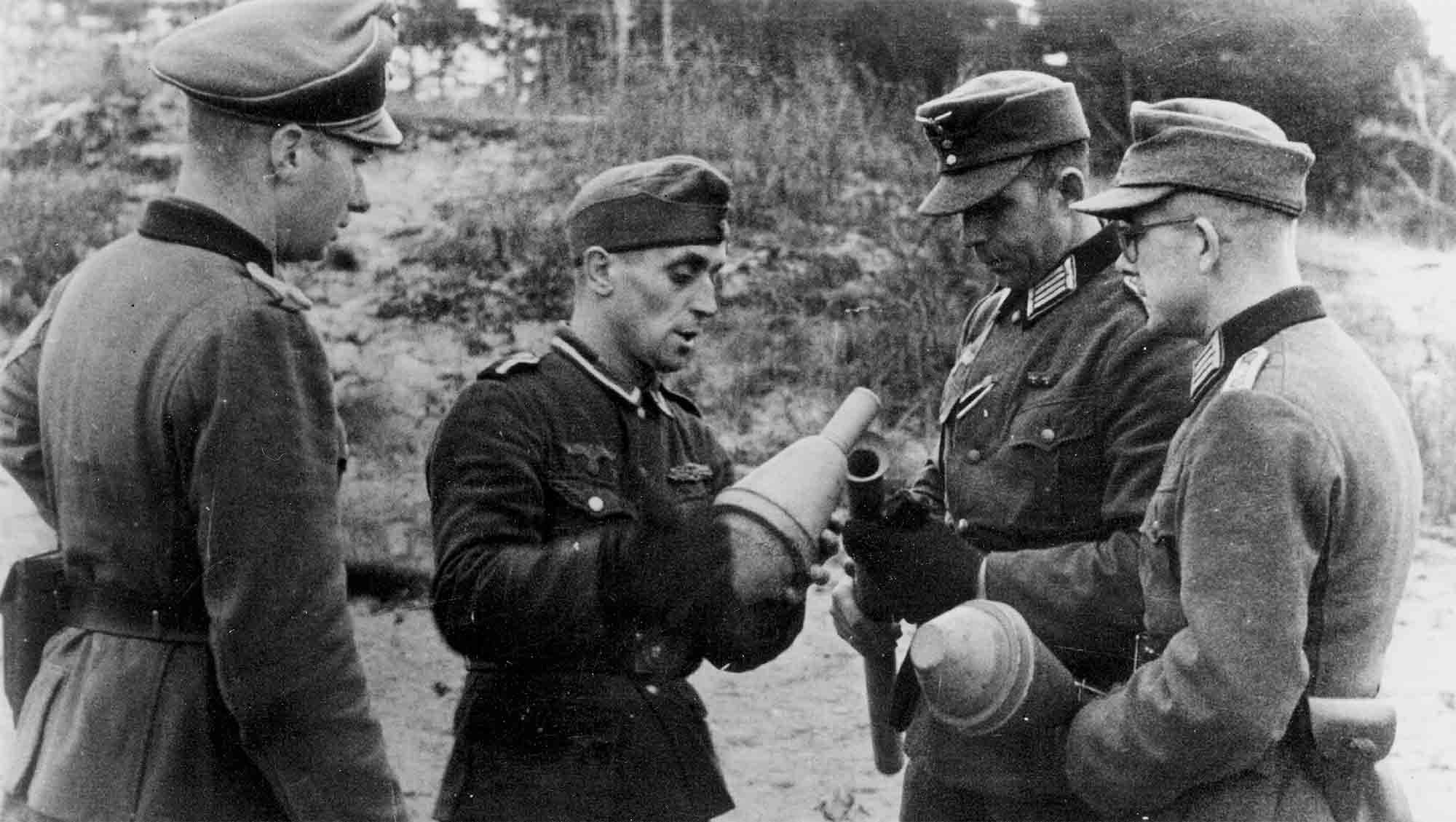
In front of a group of officers an Unteroffizier demonstrates how the shaped-charge warhead fits into the launch tube of a Panzerfaust 30. The propellant charge is packed into the launcher tube.
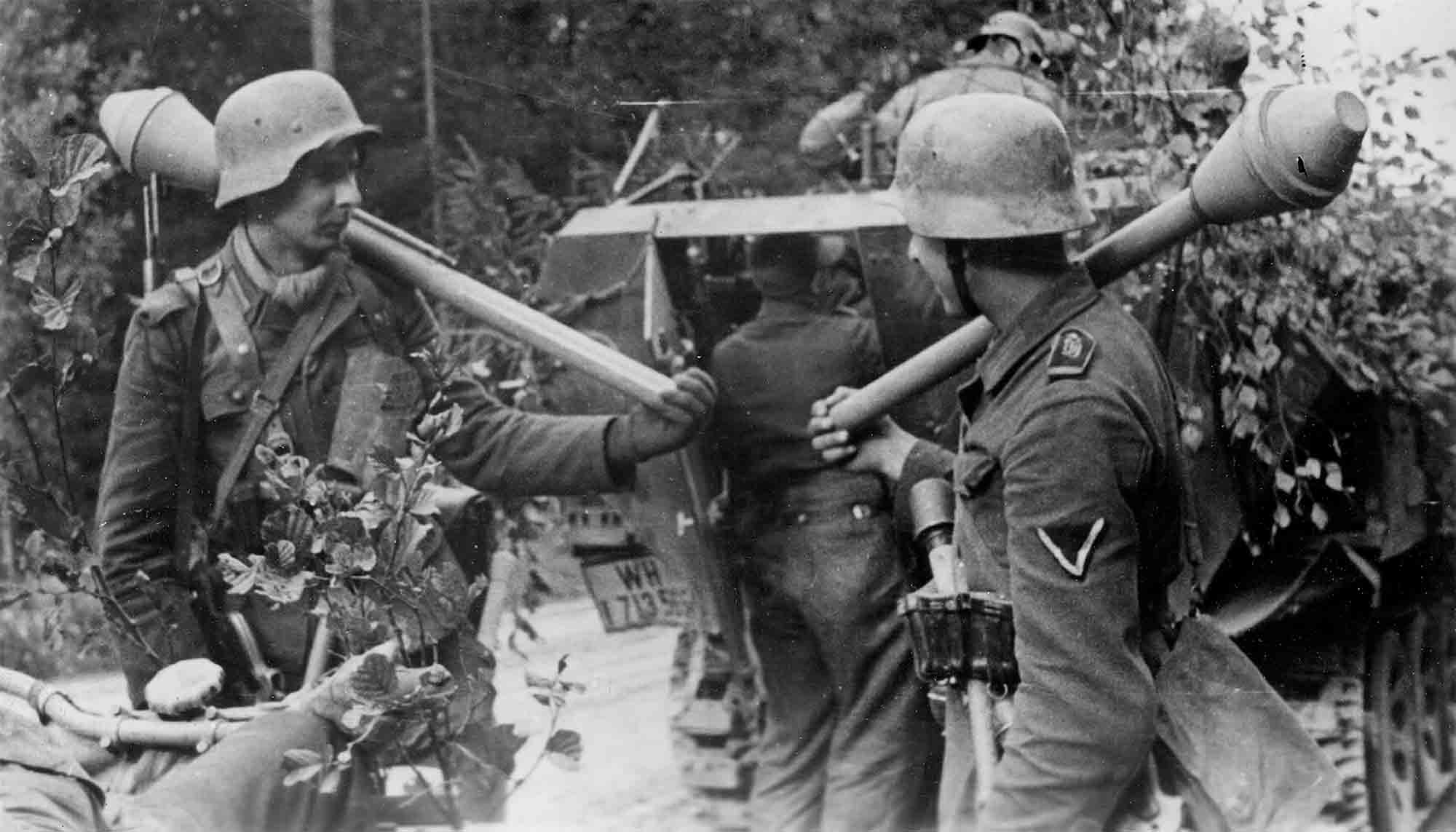
Two grenadiers converse behind a stationary Sd.Kfz.251 halftrack armed with the Panzerfaust.

Grenadiers advancing along a ditch by the side of a road armed with the Panzerfaust. The Panzerfaust remained in service in various versions until the end of the war.
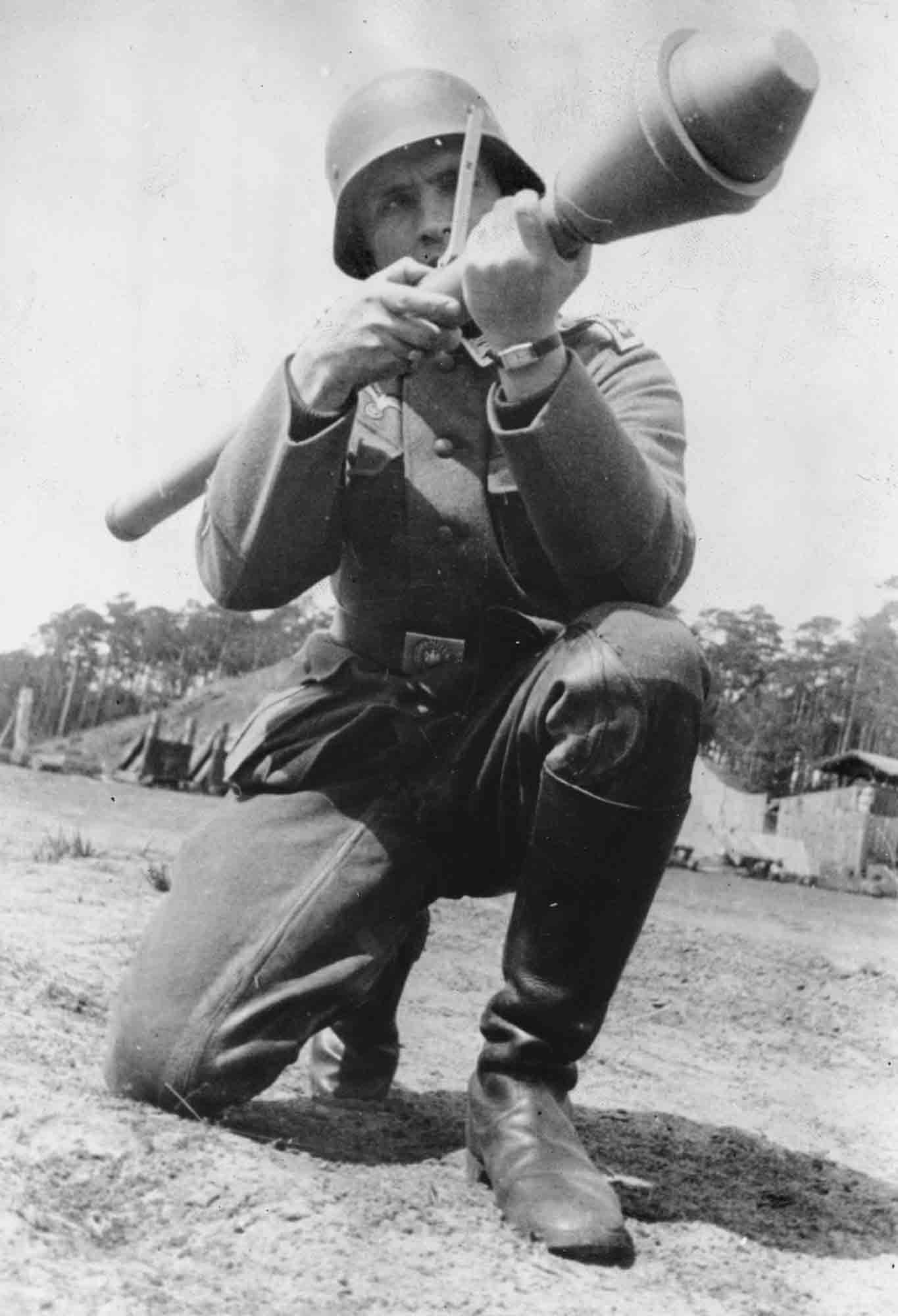
A grenadier armed with the Panzerfaust is about to fire the weapon for a propaganda photograph. There was a simple folding rear sight and a trigger on the side of the tube for firing the weapon. The edge of the warhead was used as the front sight. The oversize warhead was fitted into the front of the tube by an attached wooden tail stem with metal stabilizing fins. The warhead weighed 2.9kg and contained 0.8kg of a 50:50 mixture of TNT and hexogen. It was capable of penetrating 200mm of armour.
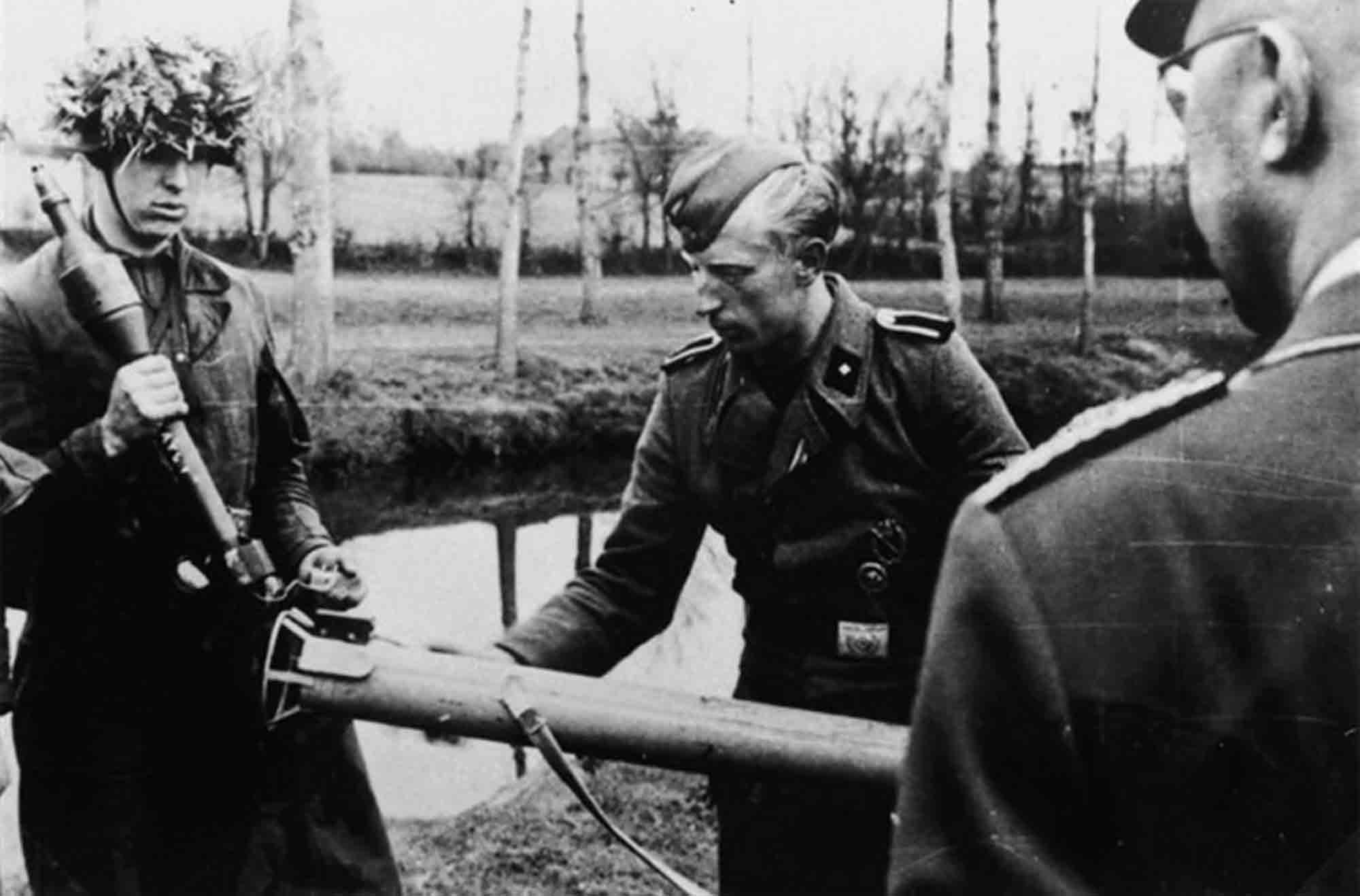
An interesting photograph of SS-Reichsführer Heinrich Himmler on the right being shown by an SS officer and a grenadier the procedure for loading the Panzerschreck. In early 1945 Himmler was commander of Army Group Vistula which was intended to halt the Soviet Army’s Vistula-Oder offensive into Pomerania. It was quickly realised that the Reichsführer was totally incompetent as an army group commander and as a consequence he was relieved of his command on 20 March 1945, being replaced by General Gotthard Heinrici.

A commanding officer training grenadiers in the use of the Panzerfaust during the last months of the war. The warhead has been placed in the tube ready for firing and the officer is showing the men the crude aiming device that was fitted onto the weapon.

A soldier armed with the Panzerfaust. It was common practice to be armed with more than one Panzerfaust as these weapons were disposable. During the last year of the war the Panzerfaust was used extensively to combat both Russian and Allied armour. This handheld rocket-propelled grenade was effective at a range of approximately 90ft. It was very light because the launch tube was made of thin low-grade steel. The propellant for the missile consisted of only 95g of black powder. The weapon became very useful against enemy tanks during the last months of the war. Some tank units even waited for infantry support before advancing to minimize the risk of being knocked out. The high kill rate by the Panzerfaust, however, is attributable mainly to the lack of German anti-tank guns late in the war and also the terrain where the fighting took place.

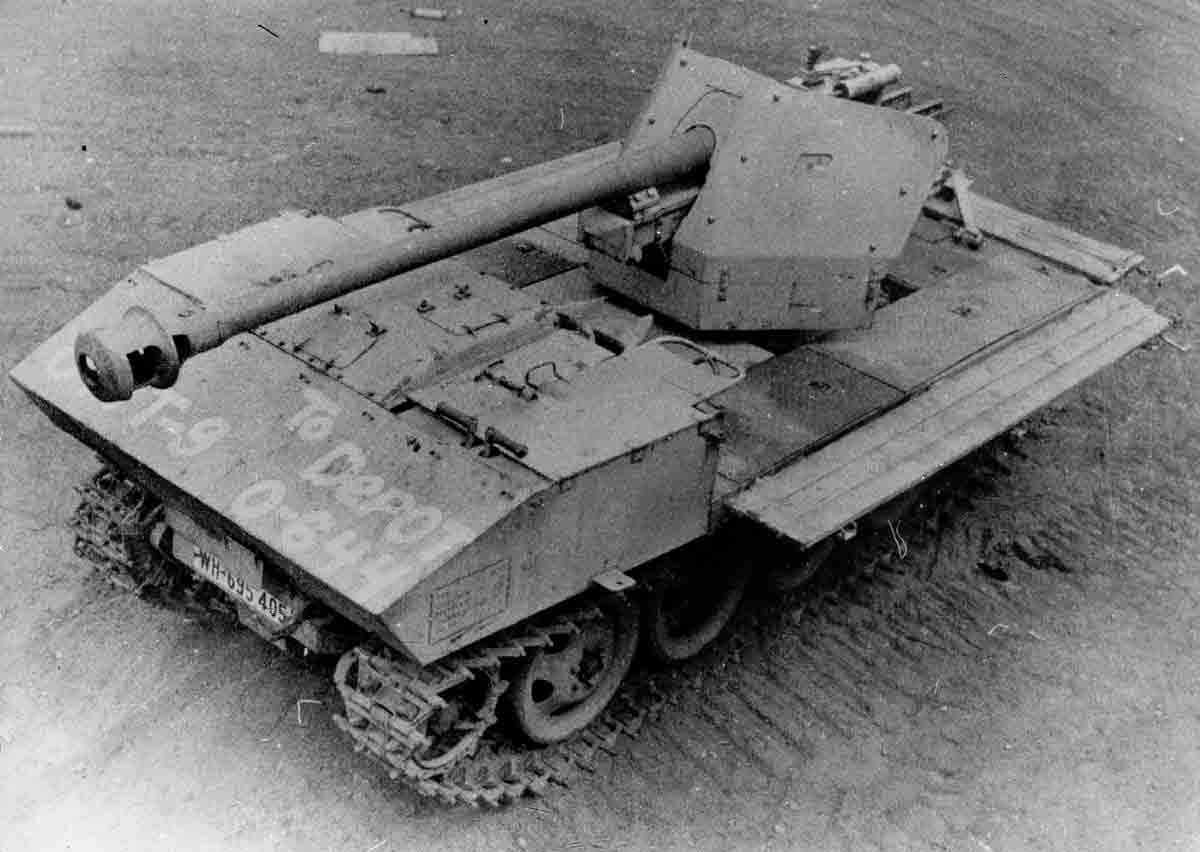
Two photographs showing what was called the RSO/PaK 40. These anti-tank vehicles consisted of a PaK 40 anti-tank gun mounted on the chassis of a RSO caterpillar tractor. The suspension of the RSO remained unchanged but the front driver’s compartment was replaced with a low, lightly armoured superstructure making the vehicle very lightweight and cheap to produce. Surprisingly, this RSO/PaK 40 anti-tank vehicle became a highly mobile infantry anti-tank weapon. However it was more exposed than the conventional, open-topped tank destroyers and as a result many were lost in action. Note in this photograph that while in action some or all the upper panels could be folded down to allow additional room for the PaK crew. From late 1944, some 23,000 RSOs of all versions were produced. Although the vehicle was intended for use by infantry anti-tank units, when the RSOs first left the factory they were immediately issued to armoured units due to the massive losses sustained on the Eastern Front.

Allied troops survey the damage to a vehicle. In the background is an abandoned Marder III, the fuel can next to the Panzerja¨ger indicating this vehicle more than likely ran out fuel. This anti-tank vehicle proved to be a very effective improvisation that married two powerful anti-tank guns with a platform to provide Wehrmacht, Waffen-SS and Luftwaffe troops with good mobile anti-tank capability. However, it did have its drawbacks. The upper structure mounted the gun and an extended gun shield only gave limited protection for the crew, so losses were high. Armour protection ranged from 10 to 50mm with no armour at all above and behind the gun compartment.
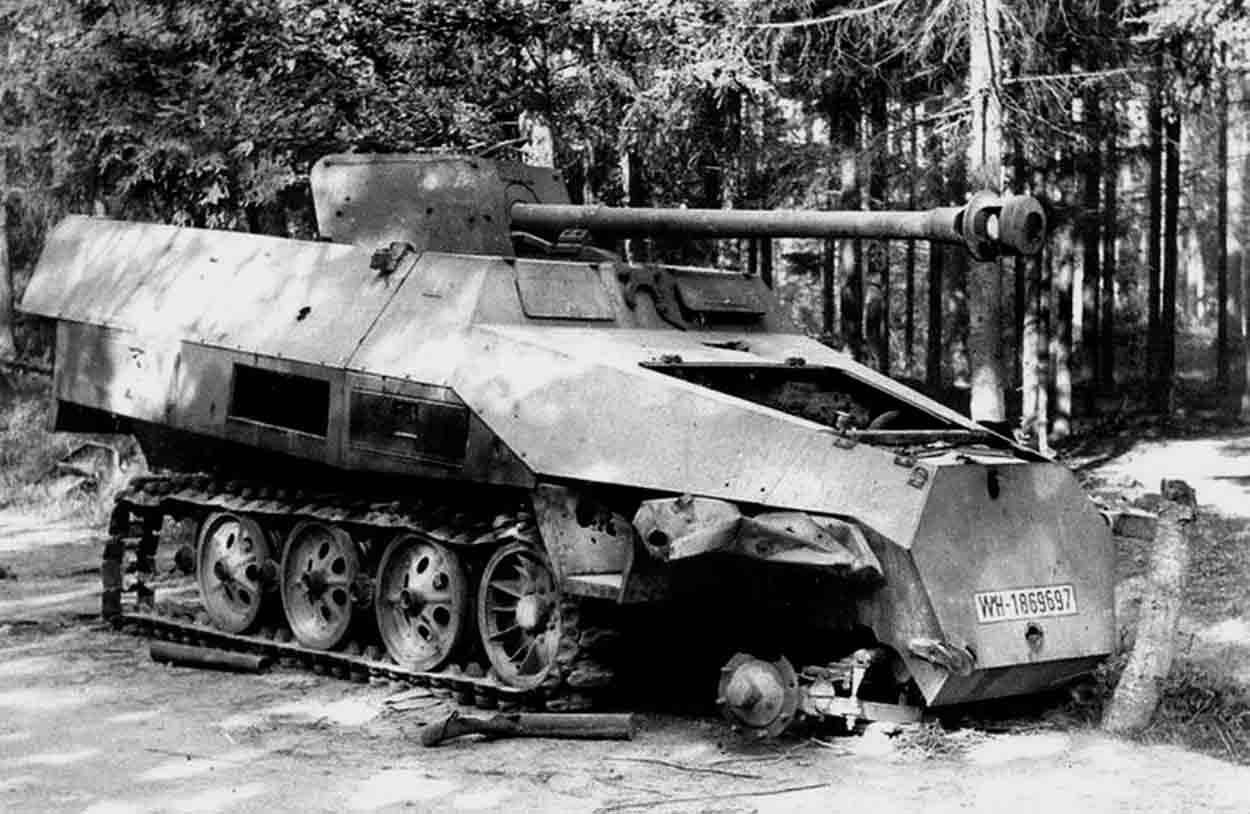
A knocked-out Sd.Kfz.251/22. This ‘Pakwagen’ was regarded as one of the best support vehicles during the war, in spite of its problems. Mounted in the compartment of this standard halftrack personnel carrier was a high velocity 7.5cm PaK 40. These vehicles were extensively used, especially during defensive actions in 1944/5. However, the halftrack was never designed to carry a gun of this size, and due to its weight it often caused the engine to overheat. The blast shock and recoil also strained the vehicle’s superstructure.

This photograph depicts the battle of Berlin in April 1945. It shows anti-tank grenadiers preparing a typical defensive position inside the city. A Panzerschreck can be seen at the ready. Berlin, however, was almost defenceless against the Red Army. Despite giving the Volkssturm the main task of defending the city, which was supported by a motley collection of Hitlerjugend, Wehrmacht, Luftwaffe and Waffen-SS troops, supplies in both weapons and ammunition were desperately low. Those fortunate enough to be armed with either a Panzerschreck or Panzerfaust stood more of a chance.








